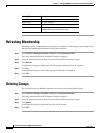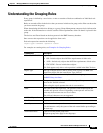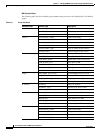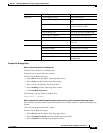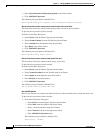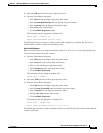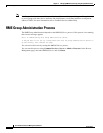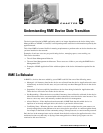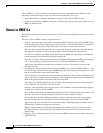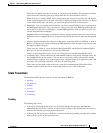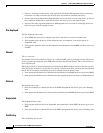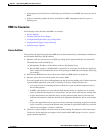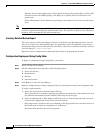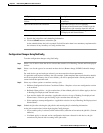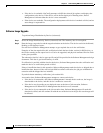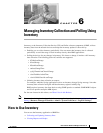
5-2
User Guide for Resource Manager Essentials 4.1
OL-11714-01
Chapter 5 Understanding RME Device State Transition
States in RME 4.x
Thus, in RME 3.x, a device had to be in managed state for most application tasks. However, some
application tasks allowed devices that were not in the managed state. They were:
• Import Status Report—Displays the number of devices in the various RME 3.x states.
• Syslog Unexpected Device Report—Displays a list of Syslogs received from devices that are not in
RME 3.x managed state.
States in RME 4.x
The following describes the states a device can be in, and some sample application scenarios to explain
the state.
The device states in RME, visible to all application are:
• Normal—Device has been successfully contacted by RME or the device has contacted RME at least
once (polling, successful job completion, Syslog receipt etc.). This indicates that this is a real device
in the network (at one point in time). Only the user can move a device out of this state.
This state does not guarantee that there was a successful Inventory Collection. Also note that the
Pre-deployed and Normal states are meant primarily for the information of the end-user.
As in the Pre-deployed state, RME should allow/disallow application tasks purely based upon the
presence/absence of the information required for that task.
In the device selector, devices in the normal state will appear in the appropriate MDF –based groups,
and in custom groups, if the data necessary to resolve group membership is available.
Application tasks initiation and execution will behave exactly as described for devices in the
pre-deployed state.
• Pre-deployed—Device has never been contacted by RME by any protocol (SNMP, SSH, etc.). Any
successful contact with the device (be it SNMP polling, pre-provisioned job completion, etc.) will
take it out of this state and into the Normal State.
This state helps you to identify the devices that are to be deployed. These devices will appear in the
device selector in a separate group, Pre-deployed. These devices also appear under the appropriate
MDF-based groups, based on the information entered in DCR.
The operator can initiate application tasks (includes jobs) using devices in this state by using the
device selector in the same way as Normal devices.
However, some application tasks may not execute or be scheduled, since the information required
for that task is not yet available in RME.
Thus, Software Managemente’s Distribution Method by devices [Advanced] flow job creation task
succeeds, since there is no data required from the device either current or cached.
On the other hand, Software Management Device Centric job creation task that requires Image
Recommendation fails since the required Flash and Image data is not yet available in RME.
Application tasks will succeed or fail on a best-effort basis without depending on whether there is a
full Inventory Collection performed on the device.
RME will have inventory and Configuration polling and collection jobs for all devices in the
pre-deployed state. If any of these jobs successfully contact the device, the device is moved to
Normal state.
• Pending—This is a transient state, and, in an operational RME, no device will be in this state for any
significant time.



